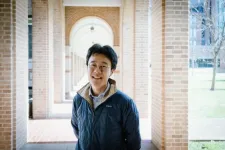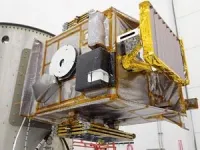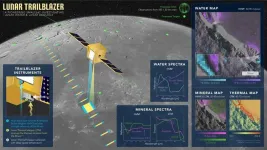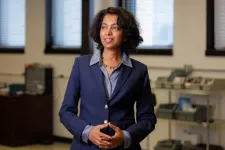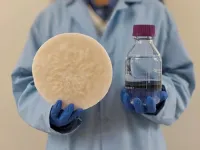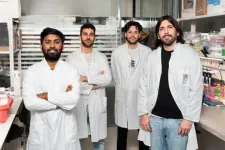(Press-News.org) As electric vehicles (EVs) gain momentum in the fight against climate change, the conversation around public charging infrastructure is growing increasingly complex. Xinwu Qian , assistant professor of civil and environmental engineering at Rice University, is spearheading research that reimagines how and where charging stations should be deployed — ensuring that alignment with people’s daily routine and activities, beyond mere accessibility, are at the forefront.
“Charging an electric vehicle isn’t just about plugging it in and waiting — it takes 30 minutes to an hour even with the fastest charger — therefore, it’s an activity layered with social, economic and practical implications,” Qian said. “While we’ve made great strides in EV adoption, the invisible barriers to public charging access remain a significant challenge.”
Qian’s work sheds light on the hidden disparities within existing public charging infrastructure. According to his research, public charging stations are more commonly located near low-income households as these residents are less likely to afford or have access to home charging. However, these stations are often far from their daily activities, making them less convenient. Conversely, while public charging stations are geographically distant from more affluent suburban neighborhoods, they tend to align better with the daily routines of these residents. This creates an opportunity gap for low-income communities, where public charging access might be available in theory but is less functional in practice.
“Disparities arising from distance measures are only part of the equation; a deeper issue emerges when we consider the actual time people can spend at different locations,” Qian said. “For lower-income households, the issue is often about time. If you’re juggling multiple jobs or family obligations, spending 30 minutes to an hour at a charging station might not be feasible, especially if it’s located far from your daily activities.”
A 2024 study led by Qian analyzed data from over 28,000 public charging stations and 5.5 million points of interest across 20 U.S. cities. The findings were stark: Income, rather than proximity, was the dominant factor in determining who benefits most from public EV infrastructure. Wealthier individuals were more likely to find a charging station at places they frequent, and they also had the flexibility to spend time at those places while charging their vehicles. Meanwhile, lower-income communities struggled to integrate public charging into their routines due to a compounded issue of shorter dwell times and less alignment with daily activities.
“Charging decisions are deeply personal,” Qian said. “People rely on intuition and habit when choosing a station, often without realizing the broader social and economic implications of their choices.”
Qian draws an unsettling comparison between today’s charging infrastructure and the interstate highway system built decades ago.
“The interstate highways were designed to connect cities, but there are many studies and evidence suggesting that they also ended up dividing communities and depriving certain neighborhoods of opportunities,” Qian said. “We’re seeing a similar pattern emerge with EV charging stations, where deployment strategies favor certain lifestyles and leave others behind. This builds upon the issues created by the interstate highways and could also exacerbate them.”
His research also highlights a troubling feedback loop: Businesses that install charging stations often target higher-income customers, perpetuating a cycle of inequity.
“It’s a sad reality,” Qian said. “If we don’t address these systemic issues now, we risk deepening the divide between those who can afford EVs and those who can’t.”
Qian’s research team is developing cognitive models that explore how people make decisions about where to charge their vehicles — research that was recently awarded a grant by the National Science Foundation. These models aim to break the “echo chamber” of intuitive decision-making, offering users strategic recommendations that align with long-term societal benefits.
Qian’s research also offers actionable recommendations for policymakers and businesses. Among them is the need to rethink how subsidies for charging stations are allocated. Instead of uniform funding, Qian advocates for targeted incentives that prioritize underserved communities and encourage businesses in these areas to install charging infrastructure.
“We can’t just rely on market forces to fix this problem,” Qian said. “Public and private sectors must work together to create an equitable charging network that benefits everyone, not just those who can afford it.”
Qian also stressed the importance of integrating charging infrastructure with community resilience strategies.
“Resilience isn’t just about preparing for disasters,” he said. “It’s about addressing chronic challenges, like ensuring that everyone, regardless of income, can participate in the transition to sustainable energy.”
As the U.S. aims to expand its EV charging network to 500,000 stations by 2030, Qian’s research provides a crucial roadmap for equitable deployment. By combining insights from engineering, sociology and behavioral psychology, he’s working to ensure that the benefits of EV adoption are distributed fairly across all communities.
“Electric vehicles are more than just a way to save money or reduce emissions; they’re an opportunity to rethink how we design our cities and serve our communities,” Qian said. “But to seize that opportunity, we need to address the inequities in our infrastructure now.”
END
Rethinking equity in electric vehicle infrastructure
Rice researcher Xinwu Qian explores hidden disparities in charging station accessibility
2025-02-25
ELSE PRESS RELEASES FROM THIS DATE:
Lunar Trailblazer blasts off to map water on the moon
2025-02-25
On Wednesday 26 February, a thermal imaging camera built by researchers at the University of Oxford’s Department of Physics will blast off to the Moon as part of NASA’s Lunar Trailblazer mission. This aims to map sources of water on the Moon to shed light on the lunar water cycle and to guide future robotic and human missions.
Once in orbit, the spacecraft – weighing 200kg and about the size of a washing machine- will map the surface temperature and composition of the ...
Beacon Technology Solutions, Illinois Tech awarded grant to advance far-UVC disinfection research
2025-02-25
CHICAGO—February 24, 2025—Beacon Technology Solutions (Beacon), with collaborators at Illinois Institute of Technology (Illinois Tech), has been awarded a grant to support a novel study on how Far-UVC technology can help mitigate the spread of infectious diseases in public spaces. The grant was awarded through the Illinois Innovation Vouchers (IIV) Program, which fosters research collaborations between small- and medium-sized enterprises and Illinois’ world-class universities.
Beacon’s flagship product is a wall-mounted smart disinfection device that uses Far-UVC 222nm light, which has been shown to disinfect up to 99.99 percent ...
University of Houston researchers paving the way for new era in medical imaging
2025-02-25
New technology developed by researchers at the University of Houston could revolutionize medical imaging and lead to faster, more precise and more cost-effective alternatives to traditional diagnostic methods.
For years, doctors have relied on conventional 2D X-rays to diagnose common bone fractures, but small breaks or soft tissue damage like cancers often go undetected. More expensive and time-consuming MRI scans are not always suitable for these tasks in these detection or screening settings. Now, Mini Das, Moores professor at UH’s College of Natural Sciences and Mathematics and Cullen College ...
High-tech startup CrySyst provides quality-by-control solutions for pharmaceutical, fine chemical industries
2025-02-25
WEST LAFAYETTE, Ind. — International process systems and operation experts have launched high-tech startup Crystallization Systems Technology Inc. (CrySyst) to streamline processes used by companies in the pharmaceutical and fine chemical industries.
CrySyst’s quality-by-control (QbC) framework addresses crystallization monitoring, modeling and control. The framework is based on research published in the April 15, 2020, and Oct. 5, 2021, issues of the journal Crystal Growth & Design and the Sept. 22, 2022, issue of the journal Industrial & Engineering ...
From scraps to sips: Everyday biomass produces drinking water from thin air
2025-02-25
Discarded food scraps, stray branches, seashells and many other natural materials are key ingredients in a new system that can pull drinkable water out of thin air developed by researchers from The University of Texas at Austin.
This new “molecularly functionalized biomass hydrogels” system can convert a wide range of natural products into sorbents, materials that absorb liquids. By combining these sorbents with mild heat, the researchers can harvest gallons of drinkable water out of the atmosphere, even in dry conditions.
“With ...
Scientists design novel battery that runs on atomic waste
2025-02-25
COLUMBUS, Ohio – Researchers have developed a battery that can convert nuclear energy into electricity via light emission, a new study suggests.
Nuclear power plants, which generate about 20% of all electricity produced in the United States, produce almost no greenhouse gas emissions. However, these systems do create radioactive waste, which can be dangerous to human health and the environment. Safely disposing of this waste can be challenging.
Using a combination of scintillator crystals, high-density materials that emit light when they absorb radiation, and solar cells, the team, led by researchers from The Ohio State University, demonstrated that ambient ...
“Ultra-rapid” testing unlocks cancer genetics in the operating room
2025-02-25
A novel tool for rapidly identifying the genetic “fingerprints” of cancer cells may enable future surgeons to more accurately remove brain tumors while a patient is in the operating room, new research reveals. Many cancer types can be identified by certain mutations, changes in the instructions encoded in the DNA of the abnormal cells.
Led by a research team from NYU Langone Health, the new study describes the development of Ultra-Rapid droplet digital PCR, or UR-ddPCR, which the team found can measure the level of tumor cells in a tissue sample ...
Mimicking shark skin to create clean cutting boards
2025-02-25
WASHINGTON, Feb. 25, 2025 – Keeping work surfaces clean during meat processing is a challenge. Bacteria from meat can attach, grow, and build up to create a biofilm that is difficult to remove, even on stainless steel surfaces used in industrial facilities. It can also aggregate, clumping together into an invisible mass that is stronger than individual cells, making it harder to kill using food-grade antibacterial surface cleaners.
In a paper published this week in Journal of Laser Applications, from AIP Publishing and the Laser Institute of America, researchers from the Hopkirk Research Institute, New Zealand Food Safety Science and Research Centre, ...
Adherence to the Mediterranean diet and obesity-linked cancer risk
2025-02-25
About The Study: The findings of this study indicate that higher adherence to the Mediterranean diet is associated with a modest reduction in the risk of obesity-related cancers, independent of adiposity measures. Further research is needed to clarify the mechanisms by which the Mediterranean diet may contribute to cancer prevention.
Corresponding Author: To contact the corresponding author, Inmaculada Aguilera-Buenosvinos, PhD, email iaguilerabuenosvinos@gmail.com.
To access the embargoed study: Visit our For The Media website at this link https://media.jamanetwork.com/
(doi:10.1001/jamanetworkopen.2024.61031)
Editor’s Note: Please see the ...
New technique reveals how the same mutations give rise to very different types of leukaemia
2025-02-25
Barcelona, 25 February 2025 - Myeloid leukaemias are among the most aggressive blood cancers and have low survival rates. Today, leukaemia patients undergo genetic analysis to identify mutations and select the most appropriate treatment. However, even among patients with the same mutation, disease progression and response to therapy can vary significantly.
A study led by ICREA researcher Dr. Alejo Rodríguez-Fraticelli at IRB Barcelona, and funded by Fundación CRIS contra el cáncer, has now revealed these differences can be explained by the fact that not all blood stem cells ...
LAST 30 PRESS RELEASES:
New study shows how the spleen helps the immune system accept a transplant
New Mayo Clinic study advances personalized prostate cancer education with an EHR-integrated AI agent
Researchers identify novel therapeutic target to improve recovery after nerve injury
Microbes in breast milk help populate infant gut microbiomes
Reprogramming immunity to rewrite the story of Type 1 diabetes
New tool narrows the search for ideal material structures
Artificial saliva containing sugarcane protein helps protect the teeth of patients with head and neck cancer
Understanding the role of linear ubiquitination in T-tubule biogenesis
Researchers identify urban atmosphere as primary reservoir of microplastics
World’s oldest arrow poison – 60,000-year-old traces reveal early advanced hunting techniques
Bristol scientists discover early sponges were soft
New study uncovers how rice viruses manipulate plant defenses to protect insect vectors
NSF–DOE Vera C. Rubin Observatory spots record-breaking asteroid in pre-survey observations
Ribosomal engineering creates “super-probiotic” bacteria
This self-powered eye tracker harnesses energy from blinking and is as comfortable as everyday glasses
Adverse prenatal exposures linked to higher rates of mental health issues, brain changes in adolescents
Restoring mitochondria shows promise for treating chronic nerve pain
Nature study identifies a molecular switch that controls transitions between single-celled and multicellular forms
USU chemists' CRISPR discovery could lead to single diagnostic test for COVID, flu, RSV
Early hominins from Morocco reveal an African lineage near the root of Homo sapiens
Small chimps, big risks: What chimps show us about our own behavior
We finally know how the most common types of planets are created
Thirty-year risk of cardiovascular disease among healthy women according to clinical thresholds of lipoprotein(a)
Yoga for opioid withdrawal and autonomic regulation
Gene therapy ‘switch’ may offer non-addictive pain relief
Study shows your genes determine how fast your DNA mutates with age
Common brain parasite can infect your immune cells. Here's why that's probably OK
International experts connect infections and aging through cellular senescence
An AI–DFT integrated framework accelerates materials discovery and design
Twist to reshape, shift to transform: Bilayer structure enables multifunctional imaging
[Press-News.org] Rethinking equity in electric vehicle infrastructureRice researcher Xinwu Qian explores hidden disparities in charging station accessibility
